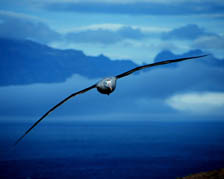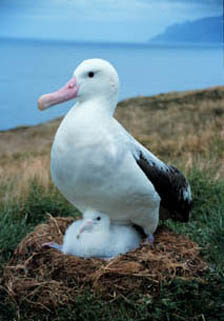
April 9, 2001
Researchers analyze flight performance in wandering albatrosses
By Tim Stephens
A new study of flight performance in wandering albatrosses reveals significant differences
between males and females and between adults and fledglings, and suggests that these
differences influence where birds of different ages and sexes forage for food in
the open sea.
 |
| A new study of the flight of wandering albatrosses, such as this juvenile in the
Crozet Islands, above, focuses on sex differences and differences between birds of
different ages. Below, a female stays close to her chick in a Crozet Islands nest. Photos: Scott Shaffer, UCSC |
 |
Wandering albatrosses have long been admired as graceful masters of soaring flight. They spend most of their lives at sea, using the wind to travel tremendous distances in search of food.
The new study is part of an ongoing research program investigating the physiology and ecology of these magnificent birds. The research involves biologists from UCSC in collaboration with Henri Weimerskirch and his colleagues in the French National Center for Scientific Research (CNRS).
Weimerskirch has been studying albatrosses for the past 18 years from research
stations on Crozet, Kerguelen, and Amsterdam Islands in the southern Indian Ocean,
between South Africa and Antarctica.
Shaffer and professor of ecology and evolutionary biology Daniel Costa began working
with Weimerskirch in 1997. Their flight performance study is published in the April
issue of the journal Functional Ecology.
At a breeding site for wandering albatrosses in the Crozet Islands, Shaffer made
detailed measurements of body size, wingspan, and wing surface area on 56 birds,
including adults and fledglings of both sexes. "We found significant morphological
differences between males and females, and also between adults and fledglings,"
Shaffer said.
On average, males are heavier than females and the length and surface area of their
wings are greater. Analyzing the data in terms of flight performance, Shaffer found
that a factor called wing loading (weight divided by wing area) is significantly
greater in males than females. In addition, he found that projected wing loading
in fledglings is lower than in adults.
These findings are consistent with differences in wind conditions in the regions
where birds of different sexes and ages are known to forage, Shaffer said. The higher
wing loading in males means they require higher wind speeds to stay aloft without
flapping their wings. Male wandering albatrosses typically forage in the extremely
windy sub-Antarctic and Antarctic zones south of the breeding colony in the Crozet
Islands (located at 46 degrees south latitude). Females tend to forage in subtropical
and tropical waters to the north, where winds are lighter. Fledglings forage farther
north in even lighter wind conditions than adults of either sex.
Albatrosses in general have high wing loading compared to most other birds. Their
long, slender wings minimize drag and enable albatrosses to ride the wind while expending
very little energy to stay aloft. The wandering albatross is the largest of the albatrosses
and has the longest wings of any bird, with wingspans commonly exceeding 10 feet.
Weimerskirch and his colleagues, including Shaffer and Costa, showed in another study
published last year that the metabolic rate of a wandering albatross in flight is
not much greater than when the bird is sitting on its nest. (The paper appeared in
the Proceedings of the Royal Society of London, Biology, in October 2000.)
"Based on our measurements of heart rates, soaring flight for wandering albatrosses
is incredibly cheap in terms of metabolic costs," Shaffer said.
The downside of this superb adaptation to soaring flight is that when an albatross
has to flap its wings, as during takeoffs and landings or if there is no wind to
soar on, the energy costs are high. The fact that 11 of the 14 albatross species
occur in the Southern Hemisphere has been attributed to the consistently strong winds
in the far southern latitudes, where the prevailing westerlies are largely unobstructed
by land masses, Shaffer said. The latitudes frequented by male wandering albatrosses
are among the windiest places on Earth, nicknamed by sailors the "roaring forties,"
"furious fifties," and "screaming sixties."
A male albatross foraging too far north would be likely to encounter winds too light
to sustain efficient soaring flight. But a female wandering albatross would not necessarily
be at a disadvantage in the higher winds to the south where the males typically forage,
Shaffer noted.
"It may be that the sexes forage in different places to avoid competing with
each other or to maximize the amount of area one pair of birds can cover in search
of food," Shaffer said.
For the fledglings, foraging in areas with light winds would enable them to develop
their flight skills and foraging abilities in favorable conditions during their first
months at sea. This research was funded by the National Geographic Society and the
National Science Foundation.
Return to Front Page
![]()